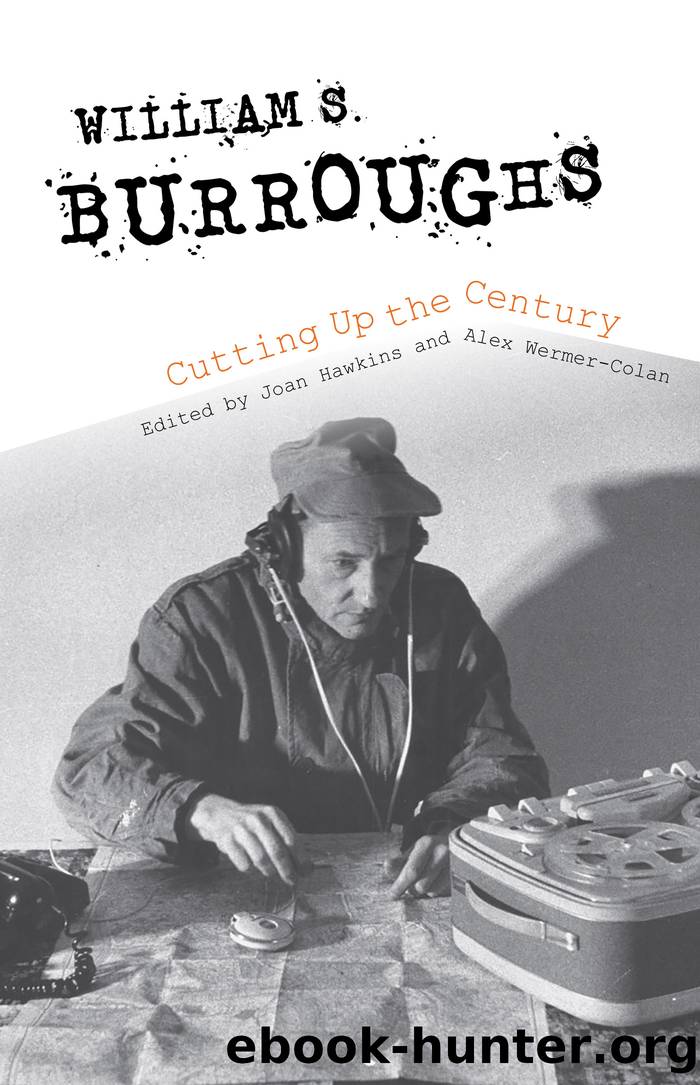William S. Burroughs Cutting Up the Century by Unknown

Author:Unknown
Language: eng
Format: epub
Publisher: Indiana University Press
Published: 2019-10-14T16:00:00+00:00
William S. Burroughs with Maurice Girodias, the publisher of Naked Lunch, by Brion Gysin, 1959. Photograph courtesy of Barry Miles.
On Addiction
These two archival pieces (the first from 1970 London, the second from 1957 to 1959 in Tangier) splice together from different angles Burroughsâ meditations on the nature of existence, being, desire, and language. Burroughs understood that the rising consumer culture of his era, manipulated by an elite class, could impose on the populace unimaginable addictive needs for commodity fetishes. The essay, âOn Addiction,â originates from Burroughsâ so-called âword hoard,â the mass of manuscript material he accumulated during a feverish period of writing that fed into and created his 1959 masterpiece, Naked Lunch. In terse, theoretical prose, Burroughs articulates his theory of addiction in terms critically explicated as early as Eric Mortimerâs The Algebra of Need (1971). Whereas âOn Addictionâ was written before Burroughs picked up the cut-up method, the first piece published here, âTO BE=TO,â was created at the other end of his cut-up period. If Burroughs was still busy in his alchemistâs kitchen of addiction when composing his obscene visions in Naked Lunch, seeking to purge and exorcise the burden of word and image, this late cut-up routine appeared after Burroughs had cut his way out, detached himself from the âreality studio,â in order to speak out as a prominent countercultural figure.
Burroughs dates âTO BE=TOâ at âMarie Celeste 21 1970.â By this time, Burroughs had set his monthly calendar system to begin on December 23, 1969 (âThe Creationâ), each following month being constituted of twenty-three days, just like the Mayan Calendar. Burroughs invented names for each month, such as Bellevue, Marie Celeste, Seal Point. This dream calendar, âDream Rat,â is one of Burroughsâ finest scrapbooks, containing in the Berg not just hundreds of cut-up collages but also a series of files denoting information on the system he was developing (Berg 24.1â3). Burroughs used this dating system in correspondence and notes throughout the 1970s, but unfortunately the names of months were alternated, as numbers slipped, making dating of materials from this time difficult. To properly account for the timeline of this complex work, and its interrelationships with a wide array of historical documents and events, Burroughs scholars will need to create a restored edition, ideally in digital form.
In âTO BE=TO,â after a metaphysical meditation upon the nature of being, especially its dependence on the virus of language, his routine mutates into a remix of reactionary language, as Burroughs invokes the undercurrent of anti-Semitism and racism in the populist supporters of George Wallace. This routine showcases what can be most difficult for readers today, as a single page of Burroughsâ text transforms from ostensibly metaphysical language into offensive and divisive discourse, such as conspiracy theories about insidious political double-crossing and self-sabotage. At this climactic point in his routine, Burroughs identifies the cause of this unrest, warning that âmore and more people are inexorably forced into more and more desperate conditions of survival, their inner space completely blocaded [sic] by continual pressure from without the stupid and automatic reactions of panic prevailâ (Berg 24.
Download
This site does not store any files on its server. We only index and link to content provided by other sites. Please contact the content providers to delete copyright contents if any and email us, we'll remove relevant links or contents immediately.
What's Done in Darkness by Kayla Perrin(25499)
Shot Through the Heart: DI Grace Fisher 2 by Isabelle Grey(18217)
Shot Through the Heart by Mercy Celeste(18159)
The Fifty Shades Trilogy & Grey by E L James(17773)
The 3rd Cycle of the Betrayed Series Collection: Extremely Controversial Historical Thrillers (Betrayed Series Boxed set) by McCray Carolyn(13187)
The Subtle Art of Not Giving a F*ck by Mark Manson(12903)
Scorched Earth by Nick Kyme(11830)
Stepbrother Stories 2 - 21 Taboo Story Collection (Brother Sister Stepbrother Stepsister Taboo Pseudo Incest Family Virgin Creampie Pregnant Forced Pregnancy Breeding) by Roxi Harding(11035)
Drei Generationen auf dem Jakobsweg by Stein Pia(10216)
Suna by Ziefle Pia(10185)
Scythe by Neal Shusterman(9257)
International Relations from the Global South; Worlds of Difference; First Edition by Arlene B. Tickner & Karen Smith(8607)
Successful Proposal Strategies for Small Businesses: Using Knowledge Management ot Win Govenment, Private Sector, and International Contracts 3rd Edition by Robert Frey(8416)
This is Going to Hurt by Adam Kay(7692)
Dirty Filthy Fix: A Fixed Trilogy Novella by Laurelin Paige(6450)
He Loves Me...KNOT by RC Boldt(5804)
How to Make Love to a Negro Without Getting Tired by Dany LaFerrière(5375)
Interdimensional Brothel by F4U(5302)
Thankful For Her by Alexa Riley(5158)
